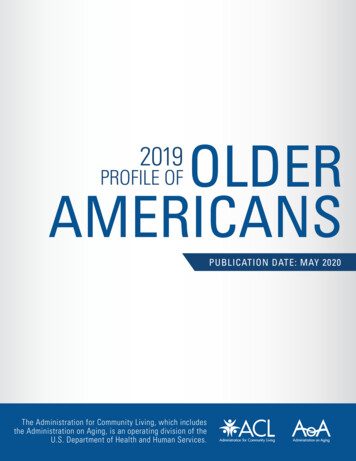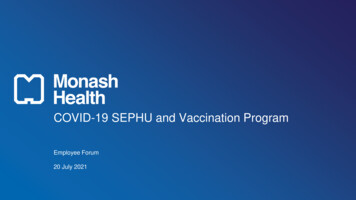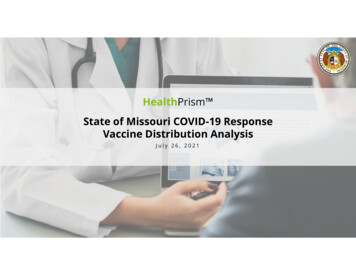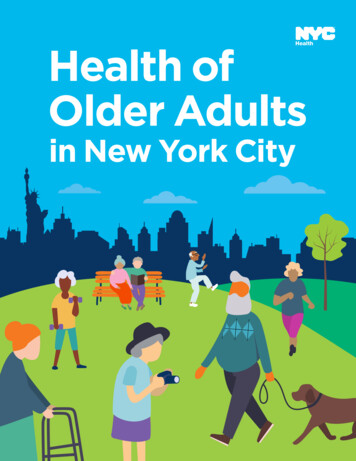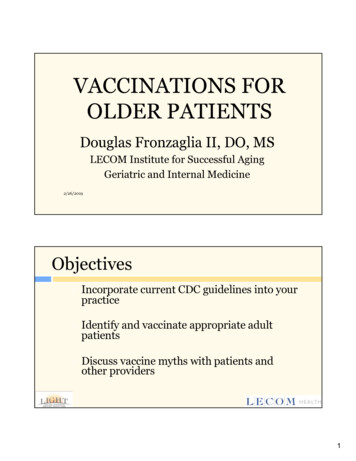
Transcription
VACCINATIONS FOROLDER PATIENTSDouglas Fronzaglia II, DO, MSLECOM Institute for Successful AgingGeriatric and Internal Medicine2/26/2019Objectives Incorporate current CDC guidelines into yourpractice Identify and vaccinate appropriate adultpatients Discuss vaccine myths with patients andother providers1
IntroductionImmunization is the process whereby aperson is made immune or resistant to aninfectious disease.Vaccines stimulate the immune system toprotect the person against infection anddisease.World Health Organization, 2016Types of Vaccines Attenuated An infectious agent altered to becomeharmless or less virulentShould be avoided ifimmunocompromisedMay induce more permanent immunityWorst case: may cause diseasewww.vaccines.gov2
Types of Vaccines Inactivated Pathogen is destroyed by heat,chemicals or radiationStimulate a weaker immune responseMay require a booster doseWorst case: does not workwww.vaccines.govTypes of VaccinesToxoids Used to induce immunity against toxinsproduced by pathogensToxins inactivated with formalin torender harmlessExamples: Diphtheria and tetanuswww.vaccines.gov3
Examples of Vaccines (adult)Live Influenza(intranasal)ZostavaxVaricellaInactivated Influenza (IM) TDAP Shingrex Hepatitis A & B PneumococcalImmunosenescence Progressive, age-related deterioration in theability to respond to infectionsIncreased susceptibility to cancers andinfectionsAssociated with a higher mortality rate in theelderlyDecreased response to vaccinationsImmunology. 2007 Apr; 120(4): 435–4464
Special PopulationsSeverely immunocompromised patients Active malignancy, alcoholics, HIVShould not receive live vaccinesImmunosuppressive therapy Prednisone: 20mg daily for at least 2 weeks Wait 1 month before administering live vaccinesBiologicals: safe to administer vaccine, best to giveprior to starting therapyNational Center for Immunization and Respiratory Diseases Community Immunity Commonly known as ‘herd immunity’A critical portion of the population isimmunized against a contagious diseaseDisease reservoir is reduced or eliminatedUnvaccinated people benefit from containedcontagionThe National Institute of Allergy and Infectious Diseases (NIAID)5
Community Immunity R0 (R naught) is the number of people predictedto become infected by one personR0 for influenza is about 1.5R0 for pertussis is about 15R0 is the basis for calculating thresholdExample: R0 for measles is about 15 (Unvax pop): 1 – 15 – 225 – 3375 – 50,600 people(Vax pop 90%): 1 – 2 – 3 – 5 – 8 peopleCommunity Immunity6
Vaccination Recommendations CDC (Centers for Disease Control) Publishes schedules from recommendations madeby ACIP – Advisory Committee on ImmunizationPracticesAmerican Academy of Family PhysiciansAmerican College of Obstetrics and GynecologyAmerican College of PhysiciansAdult Immunization Schedule 20197
InfluenzaInfluenza Trivalent and quadrivalent formsAntigen selection based on recent outbreaksMay take nearly 6 months to createReduces risk by 90 % in healthy adultsReduces risk in frail elderly by 30-40% Up to 4x morbidity/mortality due to flu8
InfluenzaHigh-dose influenza vaccine Approved for people age 65 and older4x the amount of antigenReported to be 25% more effective comparedto regular doseCDC does not specifically recommendPatients more likely to develop side effects Fever, injection site painInfluenza Attenuated, intranasal vaccine Flumist: Contains 2 Type A and 2 BNot for use in immunocompromised patientsNot for use in moderate/severely ill patientsApproved for ages 2 – 49CDC does not specifically recommendwww.cdc.gov9
Tetanus, Diphtheria, Pertussis FormsTd – tetanus toxoid, diphtheria toxoidTdap – tetanus and diphtheria toxoids withacellular pertussis Recommendations Td – every 10 yearsTdap One time dose to replace Td boosterFor adults who have close contact with infants 12months oldTetanus10
Tetanus Caused by Clostridium tetaniSpores are found in soil, dust, fecesDisease does not confer immunityDisease caused by toxin Binds in the CNS, blocks neurotransmitters whichprevents muscle relaxation and causes tetanyTetanus Presents with descending symptoms Trismus (lockjaw), difficulty swallowing,muscle rigidity and spasmsSymptoms persist for about one monthOver 30% mortalityComplications: respiratory distress, bonefractures, pneumonia11
DiphtheriaDiphtheria Caused by Corynebacterium diphtheriaeCan involve any mucous membraneExudative pharyngitis is most common Pulmonary obstruction due to pseudo membraneformation12
PertussisPertussis Vaccine Whole cell pertussis vaccine (DTwP) Linked to acute encephalopathy and seizuresNo longer availableAcellular pertussis vaccine (DTaP, Tdap) Developed due side effects of DTwPContains components of cell of the bacteria Fewer AE with no reports of encephalopathy 13
Acellular Pertussis Vaccine Less effective than whole-cell vaccineGive one Tdap in place of tetanus boosterImmunized patient may be carriersRecent resurgence in whooping cough Possibly due to immunized carriersNot having received adult booster (Tdap)Unimmunized patients create reservoir of diseaseVaricella – Chicken pox14
Varicella – ShinglesVaricella Zoster Virus Chicken pox is the primary infectionHerpes zoster (“shingles”) – reactivationHighly contagiousVaricella vaccine part of childhood regimenCan be given up to age 40Unknown if life-long immunity15
Zoster Vaccine Two forms Zostavax (live attenuated)Shingrex (inactivated)Recommendation All patients over age 50Shingrex preferred due to safety and efficacy Regardless of previous varicella vaccination Zostavax Identical to varicella vaccine (attenuated)but with 15x higher titerAbout 50% effectiveCan not be given to immunocompromisedCDC recommends to adults 60 and overwww.cdc.gov16
Shingrix Recombinant zoster vaccineShould be given to all patients previouslyimmunized patientsTwo-part dose given 2 – 6 months apartPreferred vaccine by CDCFor patient age 50 and older www.cdc.gov Pneumococcal Vaccine17
Pneumococcal Vaccine Streptococcus pneumoniae 90 known serotypesDrug resistant strains are becoming morecommon – up to 30% 23 serotypes account for 85-90% of invasivedisease 13 serotypes account for 61% of disease in youngerpatientsPneumococcal Vaccine 23-valent pneumococcal poly-saccharidevaccine Pneumovax (PPSV23)Indicated for adults over age 5013-valent pneumococcal conjugate vaccine Prevnar 13 (PCV13)Indicated for adults over age 6518
Pneumococcal VaccineGeneral Recommendations All patients 65 or over – Prevnar 13 followed byPneumovax 12 months laterUnder age 65 - Pneumovax should be given inany of the following conditions: Smokers and nursing home residentsChronic heart, lung, or liver diseaseAlcoholismDiabetesRecommended Adult Immunization Schedule, Footnote 8Pneumococcal VaccineImmunocompromised recommendations No previous – Prevnar 13 followed by Pneumovaxin 8 weeks, booster in 5 years Vaccinate at least 2 weeks beforeimmunosuppressive therapy or splenectomyVaccinate newly diagnosed HIV patients early Recommended Adult Immunization Schedule, Footnote 819
Pneumococcal VaccineQualifications for immunocompromise Any immunodeficiency and malignancyTransplant patientsOrgan failure, including functional aspleniaImmunosuppressive therapyRecommended Adult Immunization Schedule, Footnote 8Vaccine Information Statements Required under the National ChildhoodVaccine Injury Act“All health care providers shall, prior toadministration of each dose of the vaccine,provide a copy to keep of the relevant currentedition www.cdc.gov/vaccines/pubs/vis20
Vaccine Information StatementsThe medical record must include: The edition date of the VISThe date it was provided to the patientName, address, and title of person administeringthe vaccineDate of administrationVaccine manufacturer and lot number www.cdc.gov/visLitigation and Liability 2016 CA law removes all exemptions forchildhood vaccinesCDC guidelines and quality measures are inplaceWould be difficult to prove preventableoutcomeWho would be liable?21
SummaryShingrix after age 50Prevnar 13 and Pneumovax 23 afterage 65, one year apartTdap once as an adult to replace TdInfluenza yearlyUse high dose influenza over 65 MYTHS About Vaccines “Aluminum leads to dementia andneurologic diseases” Used in some vaccines to improve the immuneresponse for over 70 yearsQuickly eliminatedMore aluminum is absorbed through food,drink, and antacids than vaccineswww.chop.edu; www.nap.edu;www.cdc.gov22
MYTHS About Vaccines “Formaldehyde causes blindness,encephalopathy, seizures, leukemia” Used to detoxify toxinsUsed to inactivate viral vaccinesMiniscule amount in vaccine is safewww.chop.edu; www.cdc.govMYTHS About Vaccines “The pneumonia shot doesn’t work” General misconception that the vaccine prevents allpneumonia Providers need be clear regarding the purpose 60 – 70% effective in preventing pneumococcalpneumoniawww.cdc.gov23
MYTHS About Vaccines “The flu shot doesn’t work” Age and comorbidities can be a factor Consider high-dose vaccine over age 65 Depends on the strains of virus in the vaccine Vaccine will provide at least some protection www.cdc.gov; www.chop.edu www.adultvaccination.org;MYTHS About Vaccines “I can get the flu from the vaccine” Inactivated influenza vaccine does not contain anylive virusNo chance of causing the fluMuscle aches and low-grade fever can occur Preemptively recommend acetaminophen ornsaids www.cdc.gov; www.vaccineinformation.org; www.chop.edu;24
Provider MYTHS“You have to wait at least 5 years between Tdand Tdap vaccines” There is no minimum interval between thesevaccines Could be given together if necessary www.cdc.gov www.immunize.org;Provider MYTHS “You can only give one vaccine per visit” There is no established limitAll recommended vaccines should be administeredduring the same visitLive vaccines can be given together OR separated by4 weeksInactivated vaccines can be given at any interval www.cdc.gov www.immunize.org;25
Provider MYTHS “You can’t give vaccines to ill patients” Vaccines can be given during mild acuteillness with a feverVaccines can be given during a course ofantibiotics www.cdc.gov www.immunize.org;Provider MYTHS “You need to check vitals prior tovaccination” ACIP does not recommend checking vitals beforevaccinationMild illness and fever is not a reason to withholdadministrationCan increase visit time unnecessarilywww.cdc.gov; www.immunize.org;26
Resources American Geriatric Society – www.jags.comBritish Society of RheumatologyCDC - www.cdc.gov/vaccines/Immunization Action Coalition - www.immunize.org/Morbidity and Mortality Weekly Report - www.cdc.gov/mmwr/National Foundation for Infectious Diseases - www.nfid.org/National Network for Immunization Information www.immunizationinfo.org/Natural News - www.naturalnews.comUS Pharmacist – www.uspharmacist .orgVaccine Adverse Event Reporting System - vaers.hhs.gov/WebMD – www.webmd.comQuestions27
9 Influenza High-dose influenza vaccine Approved for people age 65 and older 4x the amount of antigen Reported to be 25% more effective compared to regular dose CDC does not specifically recommend Patients more likely to develop side effects Fever, injection site pain Influenza Attenuated, intranasal vaccine Flumist: Contains 2 Type A and 2 B







